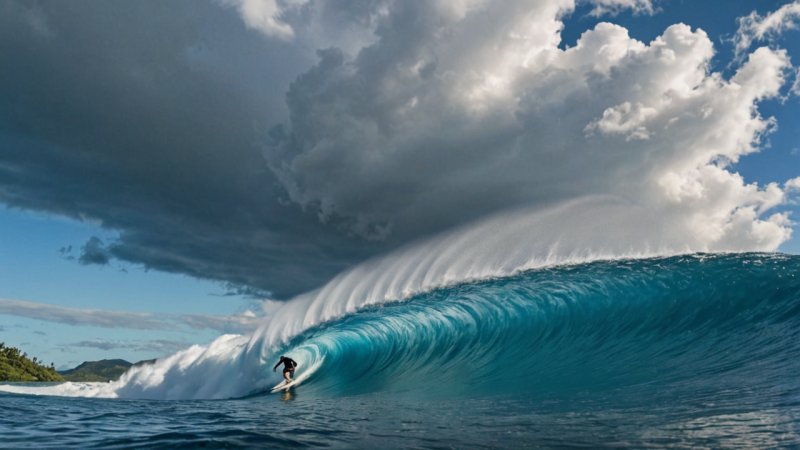For adrenaline seekers and wave riders, there are few experiences that can match the thrill of surfing some of the world's most challenging waves. From the roaring shores of Hawaii to the rugged coastlines of Portugal, these destinations not only attract seasoned surfers but also serve as meccas for adventure travel enthusiasts looking to push their limits. While the allure of these demanding waves is undeniable, it’s crucial to understand the unique challenges they present, as well as the best practices for safely navigating them. This article aims to explore some of the most notorious surf spots, the techniques required to conquer these waves, and essential tips for those daring enough to take on this exhilarating challenge.
The Legends of Big Wave Surfing
Big wave surfing is a genre that has captured the imagination of many, with spots like Jaws in Maui, Hawaii, and Teahupo'o in Tahiti standing at the forefront. These waves can reach astonishing heights, often exceeding twenty feet, and come with significant risks. Jaws, known for its monstrous and powerful waves, requires surfers to master the art of tow-in surfing, where they are pulled into the waves by jet skis. This technique has transformed the sport and opened up the ocean's door to bigger waves.
Teahupo'o, often referred to as one of the heaviest waves in the world, is renowned for its thick, heavy lips that crash onto a shallow reef, creating a breathtaking spectacle that is both beautiful and dangerous. Surfers tackling these waves must possess not only technical skills but also an acute understanding of ocean dynamics and safety protocols. The local surfing community places a strong emphasis on respecting the ocean and understanding its power, making it essential for newcomers to learn from seasoned surfers before attempting to ride these waves.
Exploring Other Challenging Surf Destinations
While Hawaii and Tahiti are iconic, other locations around the world offer equally thrilling surf experiences. The North Shore of Oahu is famous for its legendary surf competitions, with spots like Pipeline and Sunset Beach drawing in crowds from across the globe. These waves are known for their barreling tubes and can be incredibly challenging even for experienced surfers.
In addition to Hawaii, the coast of Portugal has gained recognition for its powerful swells. Nazaré, known for its gigantic waves that can reach up to 100 feet, has become a hotspot for big wave surfers. The underwater canyon just offshore amplifies wave size, creating a unique surfing experience. Surfers must be well-prepared and equipped with proper safety gear, including flotation devices and helmets, to tackle these colossal waves.
Essential Techniques for Conquering Challenging Waves
Surfing daunting waves requires a combination of technique, strength, and mental fortitude. Here are some essential skills and practices to consider:
- Paddle Power: Building upper body strength is vital for paddling out past breaking waves. This endurance will help surfers reach the lineup quicker and conserve energy for catching waves.
- Timing and Positioning: Understanding when to paddle for a wave and where to position oneself in relation to the breaking wave is crucial. Observing the waves and knowing when to take off can make all the difference.
- Reading the Ocean: Being able to read the ocean’s patterns, currents, and swell direction is key. Experienced surfers often spend time studying the water before entering to identify the best spots to catch waves.
- Fall Safely: Knowing how to fall correctly can help reduce the risk of injury. Surfers should aim to fall away from the board and avoid diving into the water headfirst.
- Emergency Protocols: Always have a plan for emergencies. This includes knowing how to signal for help, using a surf leash, and being aware of the nearest rescue services.
Safety First: Preparing for Big Wave Surfing
Safety is paramount when tackling challenging waves. Here are some tips to ensure a safer surfing experience:
- Always surf with a buddy; having someone by your side can be crucial in case of emergencies.
- Check weather and surf conditions before heading out; knowing the forecast can help you avoid dangerous situations.
- Wear appropriate safety gear, such as a wetsuit and helmet, especially for big wave surfing.
- Be respectful of local surfers and customs; each surf spot has its own etiquette, and understanding this will help foster a more rewarding experience.
- Know your limits and do not push yourself beyond what you can handle; it’s better to surf within your abilities than risk injury.
The Thrill Beyond Surfing
Beyond the waves, many of these surf destinations offer unique experiences that enrich the travel experience. From the vibrant surf culture in California to the breathtaking views of the coastlines in Australia, there is much to explore. Many surfers take the opportunity to learn about the local culture, indulge in regional cuisine, and engage with fellow surf enthusiasts. Whether it’s participating in surf competitions or attending local festivals, the surfing community provides a wealth of opportunities for connection and adventure.
Moreover, the environmental aspect of surfing cannot be overlooked. Many surfers are passionate about ocean conservation and engage in initiatives to protect marine ecosystems. By being mindful of their impact and advocating for clean oceans, surfers contribute to preserving the very playground they cherish.
Conclusion
Surfing the world's most challenging waves is not just a test of skill; it's an adventure that invites you to connect with the ocean on a deeper level. With a mix of preparation, respect for the surf environment, and a willingness to learn, anyone can embark on this thrilling journey. As you gear up for your next surfing adventure, remember that each wave tells a story, and every ride is an opportunity to embrace the unpredictability and beauty of the ocean. So grab your board, respect the power of the waves, and prepare for an unforgettable experience.






